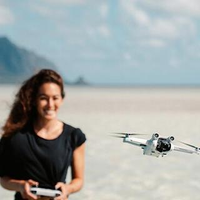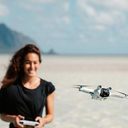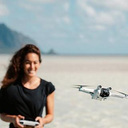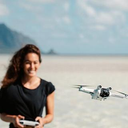DJI Mini 3 Pro DJI Mini 3 Pro is the newest and most powerful drone in our Mini series, which builds the industry’s best technology into the smallest and safest airframe. From the beginning, the Mini series has astounded our customers by delivering DJI-quality features in a tiny package, and with Mini 3 Pro, our hardworking engineers have done it again.
But how?
We sat down with one of our product managers, Lee, to openly discuss how his team approached the task of exceeding high expectations to design Mini 3 Pro. He described the challenge of building in new capabilities when every gram and millimeter is precious; how big new ideas solved problems that had resisted incremental attempts; and how his team had to forget everything they knew about using drones in order to design for customers who had their own ideas of what they wanted from DJI’s next Mini.

DJI Mini 3 Pro is small and powerful to capture any adventure. Photo by Murat Yildirim.
A New Beginning for the DJI Mini Series
To best understand how we arrived at the DJI Mini 3 Pro, it’s important to go back to why DJI made the Mini series of drones in the first place. Lee first joined the product team tasked with creating the Mini series in 2018, during a time when major drone laws and weight categories were becoming more defined.
“Ultimately, many countries adopted a weight of 250 grams as the dividing line for drones that were considered the most safe,” shared Lee. “This line gave us a clear starting point: make a drone 249 grams or lighter.”
This starting point was certainly a challenge, as no DJI drone of this weight had yet existed. No one knew whether a drone that small would be capable of doing much. But Lee and his team took this challenge as an opportunity to provide the drone community with a product that satisfied these new laws. This was also a time when drone portability was becoming more prioritized, so the team landed on two goals that a drone this light could accomplish: extreme portability and undoubted regulation compliance … while nevertheless still boasting the performance and capability to be called a DJI drone. (Make that three goals.)
Four years and three DJI Mini models later, the goals remain the same but the bar has been raised.

DJI Mini 3 Pro also introduces DJI RC. Photo by Murat Yildirim.
Facing Challenges With Fresh Perspectives
Because a weight restriction marks a clear red line in a Mini product’s development, any new feature or adjusted aspect presents a constant push toward stepping over that red line. Or in Lee’s words, “We were walking an unknown path to begin with, and the only way forward was further in.”
Product development is divided into separate teams, where each team focuses on a specific aspect of the drone, such as the propulsion system, camera system, and obstacle sensors. Whenever a team came with a new structure, they would have to see how it would affect another structure. Therefore, the production process was “a constant state of mutual checking and balancing to find the optimal solution,” according to Lee. “This entire process is a vivid example of our system engineering and teamwork.”
A perfect example of this balancing act was in developing the completely redesigned obstacle sensing system, where the rear-facing sensors are placed at the front of the drone for the first time. This placement came ultimately as a solution to a series of several challenges.
To reduce overall load, the team looked for ways to replace an internal cooling fan, which came in the form of the rear propellers and arms redesigned to feed air into a set of holes in the back. But this novel cooling solution created a tradeoff: the new propeller and arm structure would prevent the rear-facing sensors from seeing with an unobstructed view. If the propellers and rear arms were raised, it would let the rear sensors see clearly, but this would bring the propellers away from the holes, decreasing their cooling ability, which would also shorten battery life. One problem soon became a stack of them.
After several rounds of discussion and redesign, a completely different idea emerged: why not place the rear-facing sensors toward the front of the aircraft? It had never been done before, but the team found that it worked perfectly. “We suddenly found that all the problems were solved after we placed the sensors up front,” said Lee. Unique fixes like this are the heart of the team’s innovative drive.
“Sometimes, we are trapped in our own obsessions or existing perceptions when it comes to design. But a new understanding and new ideas may be the key to breaking through these kinds of bottlenecks.”

DJI Mini 3 Pro's new rear sensor and cooling design solved a stack of problems. Photo by Murat Yildirim.
Keeping All Users in Mind
The DJI Mini series made flying a drone easier than ever before, a point that Lee and the team are proud of. At the same time, they came to realize that they needed to consider a widening set of user behaviors that they had not considered before.
“In the past, finding the product’s overall direction wasn’t that difficult. Product managers are themselves users, so if a new drone satisfied their needs, it was usually aligned with what the drone community also wanted. But as the community grew, we found that there was a gap between our perception of how people use a drone and how they actually use one.”
Lee and his colleagues themselves like to take their drone for travel videos, following alongside their car and capturing the scenery around them. But they realized that other users don’t really do the same. Parents would fly for weekend fun with their children. Retirees would use it to complement their personal photography. Young users would film and publish their own content for their social media feed. To close this gap, the team had to reach out.

DJI Mini 3 Pro and DJI RC is the result of user feedback. Photo by Murat Yildirim.
“The generations of DJI Mini drones gave us a chance to build a system to communicate with users. We’re getting feedback through questionnaires, gathering user scenarios and satisfaction through surveys, and engaging in valuable conversations at retail locations and after-sales interactions. All this information helps us to see whether the original intention of the design and the actual user behavior are consistent.”
Through this feedback, Li and his team were able to deliver a drone that families can pack light and fly all weekend, a drone with a camera that photographers can trust to realize their vision, and a drone that lets aspiring content creators share unique perspectives in full-quality vertical shots. And for all, a drone that raises the bar on what someone can create. And at its core, that’s what puts the “Pro” in DJI Mini 3 Pro.
“Just because a Mini drone is portable and compliant, that doesn’t make it entry-level. DJI Mini 3 Pro represents the most power and versatility that we can currently fit into a drone that weighs less than 250 grams. It is the highest-quality and most advanced-performing drone in the safest consumer drone category.”

With True Vertical Shooting, capturing a waterfall is picture-perfect. Photo by Murat Yildirim.
DJI Mini 3 Pro: The Product of Our Work
Throughout our discussion, we often heard of the endless collaboration Lee spent with his colleagues. And for his team, it was the only way that Mini 3 Pro was possible.
“The connection and close cooperation across departments is a valuable advantage of our team. Making products with DJI technology and product capability is great, but we can also make each other better in the process of solving challenges and breaking ground with each new project. This is the most important point for us.”
And with that, Lee, his teammates, and DJI are proud to bring to you DJI Mini 3 Pro. And wherever you’re headed with it, we hope that you fly mini, create big.
All images courtesy of our own Murat Yildirim, Marketing Specialist at DJI Europe. For more work, please check out his Instagram account, muratmcmxc.
/assets/images/247410/original/130171c0-1818-4c39-839f-995ab084650c.jpeg?1450754752)

/assets/images/247410/original/130171c0-1818-4c39-839f-995ab084650c.jpeg?1450754752)


/assets/images/247410/original/130171c0-1818-4c39-839f-995ab084650c.jpeg?1450754752)
